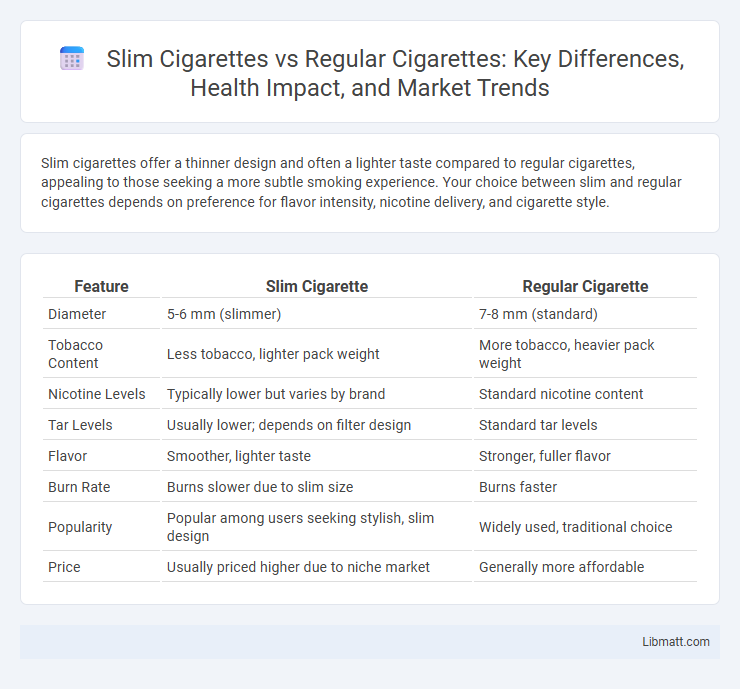Slim cigarettes offer a thinner design and often a lighter taste compared to regular cigarettes, appealing to those seeking a more subtle smoking experience. Your choice between slim and regular cigarettes depends on preference for flavor intensity, nicotine delivery, and cigarette style.
Table of Comparison
| Feature | Slim Cigarette | Regular Cigarette |
|---|---|---|
| Diameter | 5-6 mm (slimmer) | 7-8 mm (standard) |
| Tobacco Content | Less tobacco, lighter pack weight | More tobacco, heavier pack weight |
| Nicotine Levels | Typically lower but varies by brand | Standard nicotine content |
| Tar Levels | Usually lower; depends on filter design | Standard tar levels |
| Flavor | Smoother, lighter taste | Stronger, fuller flavor |
| Burn Rate | Burns slower due to slim size | Burns faster |
| Popularity | Popular among users seeking stylish, slim design | Widely used, traditional choice |
| Price | Usually priced higher due to niche market | Generally more affordable |
Overview of Slim Cigarettes vs Regular Cigarettes
Slim cigarettes have a narrower diameter compared to regular cigarettes, resulting in a lighter feel and potentially reduced smoke intake. Regular cigarettes tend to have higher tobacco content, delivering a stronger nicotine hit and more tar. Your choice between slim and regular cigarettes can influence smoking intensity, flavor, and health risks due to differences in design and chemical exposure.
Key Differences in Size and Design
Slim cigarettes have a diameter of approximately 5 to 6 millimeters, significantly narrower than regular cigarettes, which typically measure around 8 millimeters in diameter. The slim design aims to provide a more aesthetically pleasing, elegant appearance and often contains less tobacco, potentially resulting in reduced smoke volume per puff. Regular cigarettes are bulkier, offering a fuller draw and often a higher nicotine delivery due to their larger tobacco content and standard filter size.
Tobacco Content and Strength Comparison
Slim cigarettes contain less tobacco compared to regular cigarettes, resulting in a lighter smoke and reduced nicotine delivery. The tobacco in slim cigarettes is often more finely shredded, which affects the burn rate and overall strength. Regular cigarettes typically have higher tobacco content, producing a stronger flavor and greater tar and nicotine levels.
Perceived Health Risks and Misconceptions
Slim cigarettes are often perceived as less harmful than regular cigarettes, despite containing similar levels of nicotine, tar, and harmful chemicals. Research shows these misconceptions arise from their thinner design and marketing, which can mislead smokers into believing slim cigarettes are safer alternatives. Public health studies emphasize that both slim and regular cigarettes carry significant health risks, including increased dangers of lung cancer, cardiovascular diseases, and respiratory issues.
Taste and Smoking Experience
Slim cigarettes offer a lighter, more delicate taste compared to regular cigarettes, making the smoking experience smoother and less intense. The reduced diameter allows for slower burning, which can enhance flavor nuances and provide a less harsh throat hit. Your preference for a milder sensation and subtle taste profiles often guides the choice between slim and regular cigarettes.
Marketing Strategies and Consumer Appeal
Slim cigarettes are marketed through sleek, elegant packaging and advertisements emphasizing sophistication, targeting consumers seeking a refined smoking experience. They appeal primarily to women and health-conscious smokers by promoting perceptions of reduced harm and a lighter alternative to regular cigarettes. Regular cigarettes focus on brand loyalty and traditional masculine or rugged imagery, maintaining broad consumer appeal through widespread availability and established market presence.
Price and Availability
Slim cigarettes typically cost slightly more than regular cigarettes due to their specialized design and marketing towards niche consumer groups. Availability of slim cigarettes is more limited compared to regular cigarettes, often found primarily in urban areas and specialty tobacco shops rather than widespread convenience stores. Regular cigarettes dominate the market with broader distribution and lower prices, making them more accessible to the general population.
Impact on Smoking Habits and Consumption
Slim cigarettes contribute to altered smoking habits by encouraging more frequent puffs and deeper inhalation due to their thinner design and perceived lower harm, which can lead to increased nicotine intake. Studies show smokers of slim cigarettes often consume a higher number of cigarettes per day compared to regular cigarette users, potentially offsetting any reduction in tar and nicotine per cigarette. The distinct size and design of slim cigarettes influence consumption patterns, potentially sustaining or even intensifying nicotine dependence despite targeted marketing as a "lighter" alternative.
Regulatory Guidelines and Restrictions
Regulatory guidelines for slim cigarettes often mirror those for regular cigarettes, encompassing warnings on health risks, packaging requirements, and advertising restrictions set by entities like the FDA and WHO. Slim cigarettes may face additional scrutiny due to perceptions of reduced harm, with some jurisdictions imposing flavor bans or stricter marketing controls to prevent misleading health claims. Compliance with these regulations is critical to avoid legal penalties and ensure consumers receive accurate information on the risks associated with both slim and regular cigarettes.
Popularity Trends and Demographic Preferences
Slim cigarettes have seen growing popularity among young adult women seeking a perceived lighter smoking experience and stylish design, often marketed as a more elegant alternative to regular cigarettes. Regular cigarettes maintain higher overall market share, favored by older adults and males who prefer stronger nicotine delivery and traditional sizes. Your choice might reflect demographic influences, with slim cigarettes appealing more in urban areas and among fashion-conscious consumers.
Slim cigarette vs Regular cigarette Infographic

 libmatt.com
libmatt.com